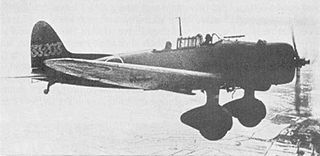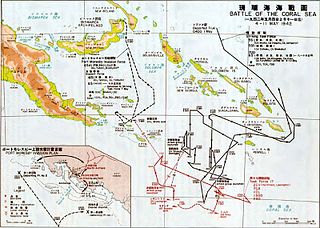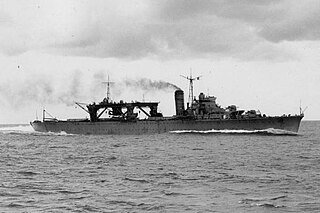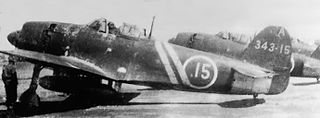
The Aichi D3A Type 99 Carrier Bomber is a World War II carrier-borne dive bomber. It was the primary dive bomber of the Imperial Japanese Navy (IJN) and was involved in almost all IJN actions, including the attack on Pearl Harbor.

The Mitsubishi A5M, formal Japanese Navy designation Mitsubishi Navy Type 96 Carrier-based Fighter (九六式艦上戦闘機), experimental Navy designation Mitsubishi Navy Experimental 9-Shi Carrier Fighter, company designation Mitsubishi Ka-14, was a Japanese carrier-based fighter aircraft. It was the world's first monoplane shipboard fighter to enter service and the direct predecessor of the famous Mitsubishi A6M "Zero". The Allied reporting name was Claude.

The Mitsubishi G4M was the main twin-engine, land-based bomber used by the Imperial Japanese Navy Air Service in World War II. The Allies gave the G4M the reporting name Betty. Japanese Navy pilots called it Hamaki due to its cylindrical shape.

This is an order of battle for the Battle of the Coral Sea. The battle, fought during 4–8 May 1942, was a major naval battle in the Pacific Theater of World War II between the Imperial Japanese Navy and Allied naval and air forces from the United States (U.S.) and Australia.

The Mitsubishi G3M was a Japanese bomber and transport aircraft used by the Imperial Japanese Navy Air Service (IJNAS) during World War II.

The Nakajima A6M2-N was a single-crew floatplane based on the Mitsubishi A6M Zero Model 11. The Allied reporting name for the aircraft was Rufe.

Chitose Air Base, is a Japan Air Self-Defense Force base located in Chitose, Hokkaidō, adjacent to New Chitose Airport. It is the JASDF's primary base in northern Japan and tasked with monitoring Japan's maritime borders with Russia. It was also Hokkaidō's primary civilian airport until the opening of New Chitose Airport in 1988. Together, these two jointly operated and connected airports create one of the largest regional airports in Japan.

Isuzu (五十鈴) was the second of six vessels in the Nagara class of light cruisers, and like other vessels of her class, she was intended for use as the flagship of a destroyer flotilla. She was named after the Isuzu River, near Ise Shrine in the Chūbu region of Japan. She saw action during World War II in the Battle of Hong Kong and in the Solomon Islands campaign, and the Battle of Leyte Gulf before being sunk by American submarines in the Netherlands East Indies in April 1945.

Operation Mo or the Port Moresby Operation was a Japanese plan to take control of the Australian Territory of New Guinea during World War II as well as other locations in the South Pacific with the goal of isolating Australia and New Zealand from their ally the United States. The plan was developed by the Imperial Japanese Navy and supported by Admiral Isoroku Yamamoto, the commander-in-chief of the Combined Fleet. The operation was ultimately abandoned.

The Yokosuka B4Y,, carrier torpedo bomber was used by the Imperial Japanese Navy Air Service from 1936 to 1943. The B4Y replaced the Mitsubishi B2M2 and was the last biplane bomber used operationally by the Imperial Japanese Navy. The Allied reporting name was "Jean".

Chiyoda was a light aircraft carrier of the Imperial Japanese Navy during World War II. Originally constructed as the second vessel of the Chitose-class seaplane tenders in 1934, she continued to operate in that capacity during the Second Sino-Japanese War and the early stages of the Pacific War until her conversion into a light aircraft carrier after the Battle of Midway. She was sunk during the Battle of Leyte Gulf by a combination of naval bombers, cruiser shellfire and destroyer-launched torpedoes.

Nisshin (日進) was a seaplane tender (CVS) of the Imperial Japanese Navy during World War II.

The 25th Air Flotilla was a combat aviation unit of the Imperial Japanese Navy (IJN) during the Pacific Campaign of World War II. The flotilla, mainly consisting of land-based bombers, fighters, and reconnaissance aircraft, reported to the IJN's 11th Air Fleet. As originally organized, the flotilla's core units were the 4th Naval Air Group, Tainan Naval Air Group, and Yokohama Naval Air Group. The 4th flew bombers, the Tainan fighters, and the Yokohama reconnaissance aircraft.

The Tainan Air Group was a fighter aircraft and airbase garrison unit of the Imperial Japanese Navy (IJN) during the Pacific campaign of World War II. The flying portion of the unit was heavily involved in many of the major campaigns and battles of the first year of the war. The exploits of the unit were widely publicized in the Japanese media at the time, at least in part because the unit spawned more aces than any other fighter unit in the IJN. Several of the unit's aces were among the IJN's top scorers, and included Hiroyoshi Nishizawa, Saburō Sakai, Junichi Sasai, Watari Handa, Masaaki Shimakawa, and Toshio Ōta.
The 4th Air Group was a land-based bomber aircraft unit of the Imperial Japanese Navy Air Service (IJNAS) during the Pacific campaign of World War II. The unit was formed on 10 February 1942 and flew the Mitsubishi G4M Rikko Navy Type 1 Attack Bomber aircraft. That same month, the 4th Naval Air Group (NAG) deployed to Rabaul, New Britain and supported Japanese operations during the early stages of the New Guinea Campaign, first as part of the 24th Air Flotilla and from April as part of the 25th Air Flotilla. The newly arrived unit took heavy losses on 20 February during an action off Bougainville, losing 15 of 17 bombers sent to attack a United States Navy aircraft carrier task force.

The Genzan Air Group was an aircraft and airbase garrison unit of the Imperial Japanese Navy Air Service during the Second Sino-Japanese War and Pacific campaign of World War II.

The World War II Allied names for Japanese aircraft were reporting names, often described as codenames, given by Allied personnel to Imperial Japanese aircraft during the Pacific campaign of World War II. The names were used by Allied personnel to identify aircraft operated by the Japanese for reporting and descriptive purposes. Generally, Western men's names were given to fighter aircraft, women's names to bombers, transports, and reconnaissance aircraft, bird names to gliders, and tree names to trainer aircraft.

The Kisarazu Naval Air Group was an aircraft and airbase garrison unit of the Imperial Japanese Navy Air Service during the Second Sino-Japanese War and the Pacific campaign of World War II.
The 24th Air Flotilla was a combat aviation unit of the Imperial Japanese Navy (IJN) during the Pacific Campaign of World War II. The flotilla, mainly consisting of land-based bombers, fighters, and flying boats, reported to the IJN's 4th Fleet. As originally organized, the flotilla's core units were the 4th Air Corps, Yokohama Air Corps, and 1st Air Corps.
The 204 Air Group was a unit of the Imperial Japanese Navy (IJN) during the Pacific campaign of World War II. The unit was formed on 1 November 1942 by re-designating 6th Air Group and served in New Guinea and Rabaul. The air group was disbanded in April 1944.


















